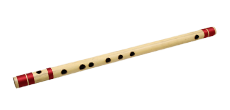
Indian bamboo flute is a very famous wind instrument commonly used to play Indian classical, folk and film music in India. It has seven holes and for every key, one can use a dedicated flute to get the best possible range of notes (generally ranging from lower flat fifth to upper fifth note covering 2 octaves). Small sized flutes produce high and sharp sound which are used to play folk or film music and long length flutes can produce soothing, low, dense and sweet sound which is generally used to play Indian classical solo. Lord Krishna is said to be the greatest player of the flute of all time that is why bamboo flute in India is known as God's instrument. Pt.Hariprasad Chaurasia , a maestro from India, is a very famous flautist who has performed concerts all over the world.
Sample 01 (Instrumental)
Sample 02 (Instrumental)
Sample 03 (Instrumental)
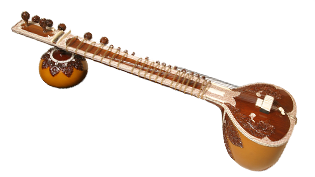
Sitar is a plucked stringed instrument of India which has frets. It has a gourd resonating chamber. It gets its resonance from sympathetic strings, a typical bridge design and long hollow neck. It has two styles in its construction and playing mainly known as Ravishankar style and Vilayat khan style. Bending of notes ('meend' in Indian classical music) is possible in this instrument which creates a unique and musically enriching sound. The world famous sitar player Late Pt.Ravishankar was the maestro of sitar who popularized Indian music and the instrument in the western countries.
Sample 01 (Instrumental)
Sample 02 (Instrumental)
Sample 03 (Instrumental)
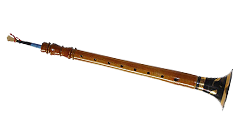
Shehnai is a famous wind instrument of India. It has seven holes, a range of one and half octaves and is made from pure teak wood or burma teak wood. It is played in temples and in marriages and many auspicious functions thus shehnai has an association with auspicious functions and programs with it The unique thing about shehnai is it can produce a very happy mood and intense or sad mood with the same intensity. It has a unique mix of power and sweetness in it. Late BharatRatna Ustaad Bismilla Khan is a world famous shehnai maestro who popularized playing Indian classical music on shehnai.
Sample 01 (Instrumental)
Sample 02 (Instrumental)
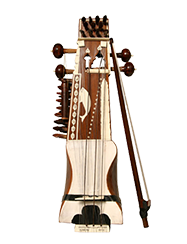
Sarangi is perhaps the only fretless Indian stringed instrument which can get very close to Indian classical vocal style of singing. Sarangi is played with a bow and it has a unique sound created with the resonance of sympathetic strings to the main string. Meend , gamak, taan, aalap and harkat are the elements in Indian classical vocal singing which can be reproduced on sarangi. Sarangi is preferred for accompaniment over any other instrument with Indian classical music because it is fretless. It can produce a specific pitching from raaga to raaga unlike any other tempered scale instruments. Late Pt.Raam narayan and Late Ustaad Sultaan Khan are the famous sarangi maestros from India.
Sample 01 (Instrumental)
Sample 02 (Instrumental)
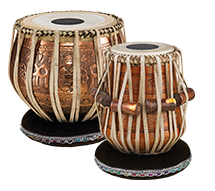
Tabla is a very unique rhythm instrument which has a bass drum called “bayaan” and a middish snare drum called “dayaan” which is also known as Indian drums. But unlike drums, Tabla is played with hands and not with the sticks. Tabla has a rhythmic language of its own which is used to describe the rhythms and patterns. It is commonly used for accompanying Indian classical vocal and instrumental music, Ghazals, semi classical music, light music and Indian film music. Tabla also has a long tradition of classical solo playing. Legendary players like Late Ustaad Ahmedjaan Thirakwa , Late Ustaad Allarakha and Ustaad Zakir Hussain are the real maestros of tabla.
Sample 01 (Instrumental)
Sample 02 (Instrumental)
Sample 03 (Instrumental)
Sample 04 (Instrumental)
Sample 05 (Instrumental)
Sample 06 (Instrumental)
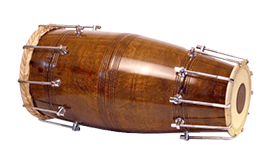
Dholki also known as 'Naal' is a folk rhythm instrument of Maharashtra state in India. It is generally used to accompany with Laavni; a musical folk form which starts with a dholki solo generally. Dholki is generally tuned in A flat, A or B flat. Is is very difficult to play dholki with a punch and maintain the sweetness of tone. Madhav Pawar, Rajabhau Jamsandekar and Vijay Chavan are some of the senior famous players of dholki from Indian music industry. Krishna Musale, Anil Karanjavkar, Satyajeet Jamsandekar and Nilesh Parab are the young and talented players of this instrument.
Sample 01 (Instrumental)
Sample 02 (Instrumental)
Sample 03 (Instrumental)
Sample 04 (Instrumental)
Sample 05 (Instrumental)
Sample 06 (Instrumental)
Sample 07 (Instrumental)
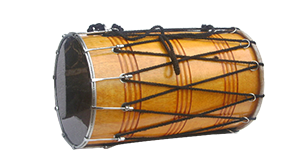
Dhol is a Punjabi rhythm instrument which is used to accompany 'Bhangra,' a rhythmic musical style of Punjab in India. In Maharashtra, it has a different style of playing with hands (Not with sticks like Punjab). It is called Dhangari Dhol in Maharashtra. Dhol gives the rhythm a masculine character with a punch and power. It can make people dance automatically after listening to it. Rhythm patterns and rolls are played on Dhol to make people dance but it needs a lot of energy and practice to develop the stamina to play the instrument. 2/4 , 4/4 and 6/8 are commonly used time signatures in which dhol is played.
Sample 01 (Instrumental)
Sample 02 (Instrumental)
Sample 03 (Instrumental)
Sample 04 (Instrumental)
Sample 05 (Instrumental)
Sample 06 (Instrumental)
Copyright © 2016 · All Rights Reserved. indianmusicarrangement.com